Abstract
On avoidance procedures, rats and pigeons typically show warmup effects, characterized by improving performance within sessions and loss of the improvement (“warmup decrement”) between sessions. Between-session losses were examined by varying the time between periods of avoidance training. In one experiment, rats lived fulltime in conditioning chambers while intermission intervals were varied. In a second experiment, the animals lived in home cages between sessions; timeout intervals were introduced at midession, producing recurrence of warmup in the second half-session. In both experiments, the warmup decrements increased substantially as the timeout or intersession intervals were increased from zero to 30 minutes. With intervals of 60 or 120 minutes, the decrements approached or exceeded those obtained with intervals of a day or more. When avoidance was interposed between appetitive sessions, the appetitive responding was disrupted, but this seemed unrelated to the warmup or to the proficiency of avoidance. The warmup in avoidance shares characteristics with transient punishment effects, with the Kamin effect, and with habituation phenomena, but it is premature to assume that they reflect common processes.
Keywords: warmup, avoidance, suppression, punishment, Kamin effect, lever press, chain pull, rats
Full text
PDF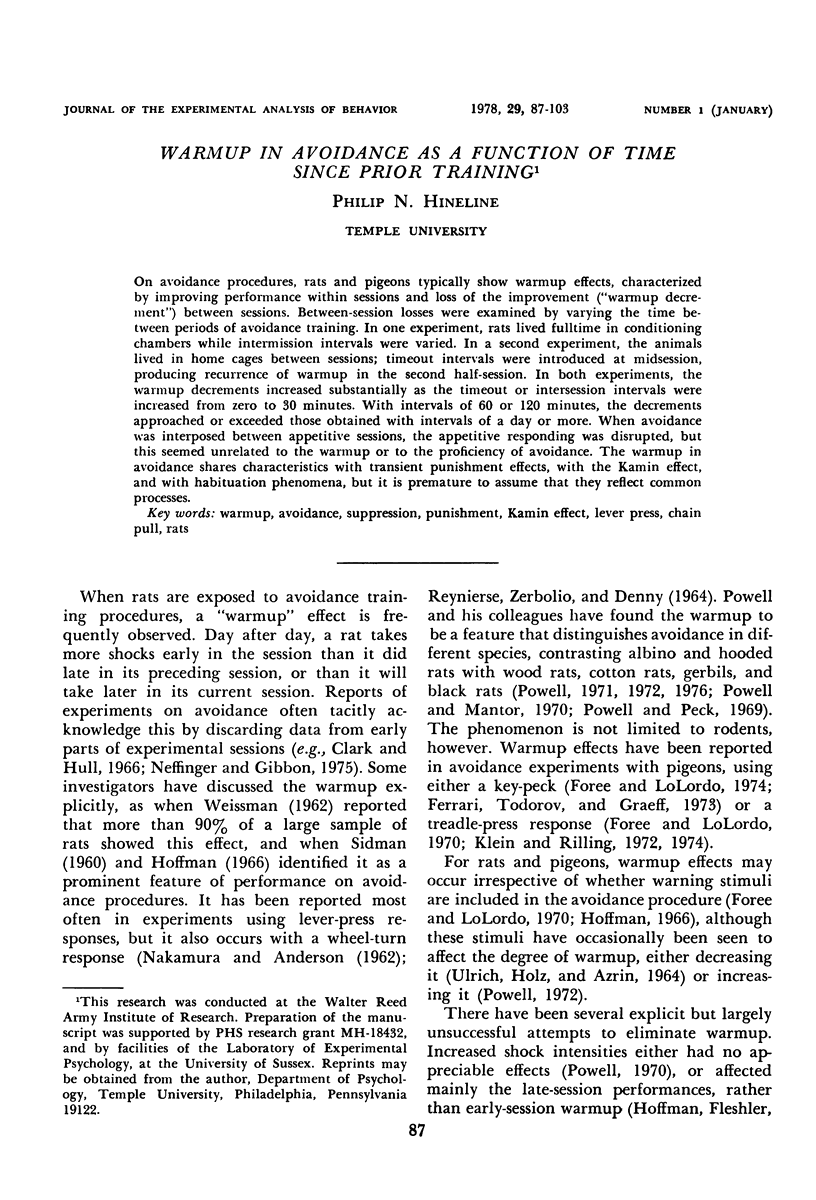
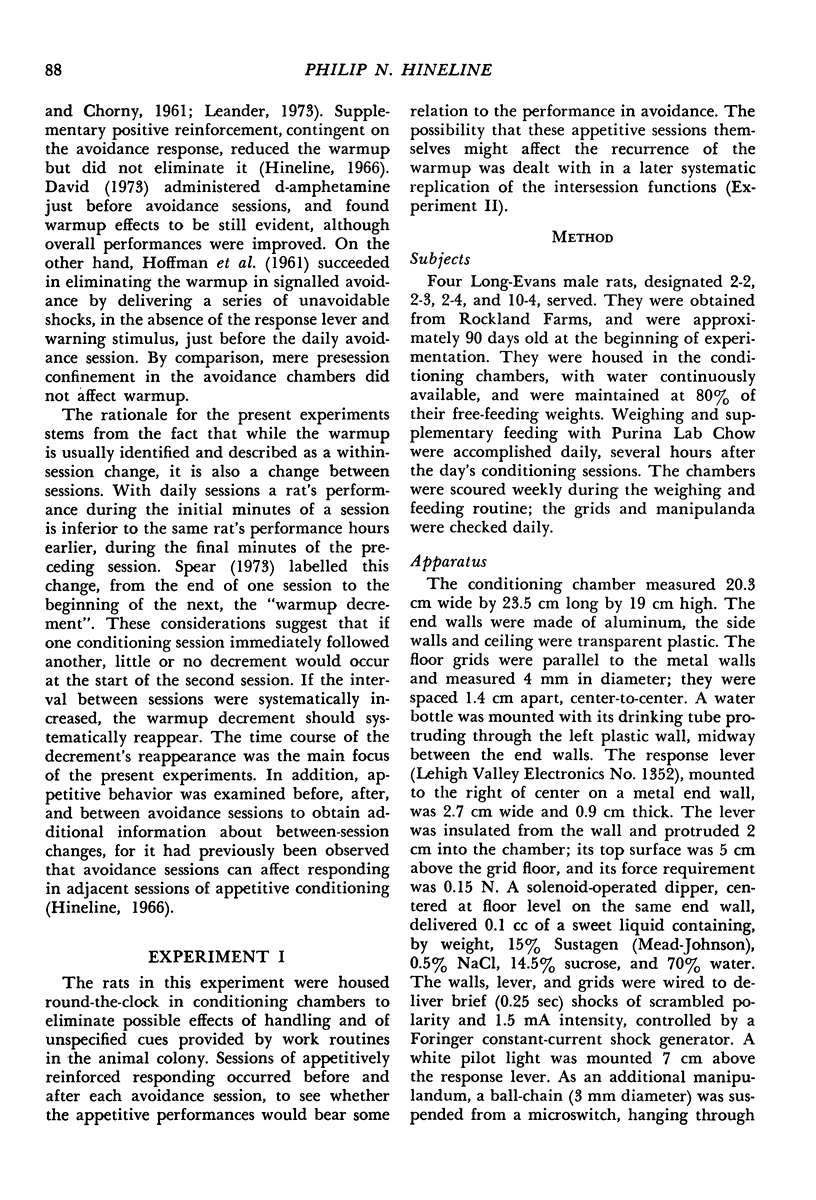
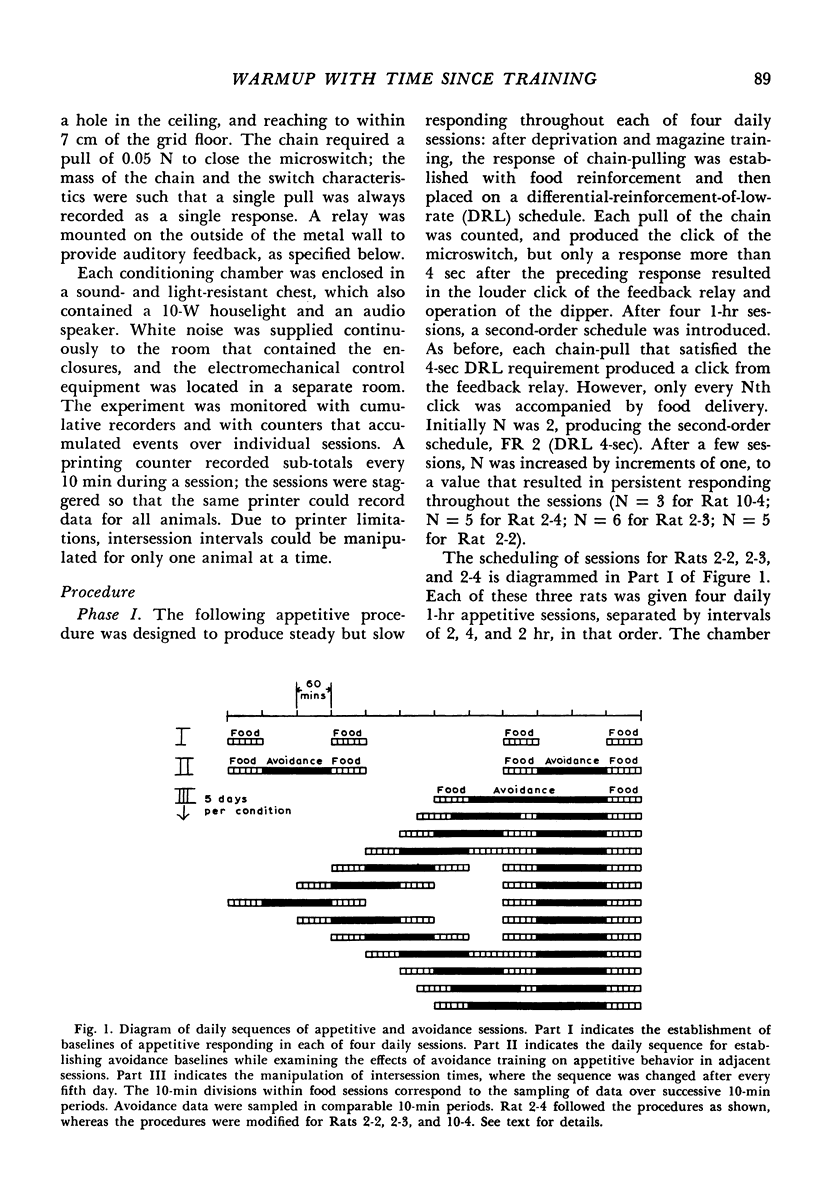
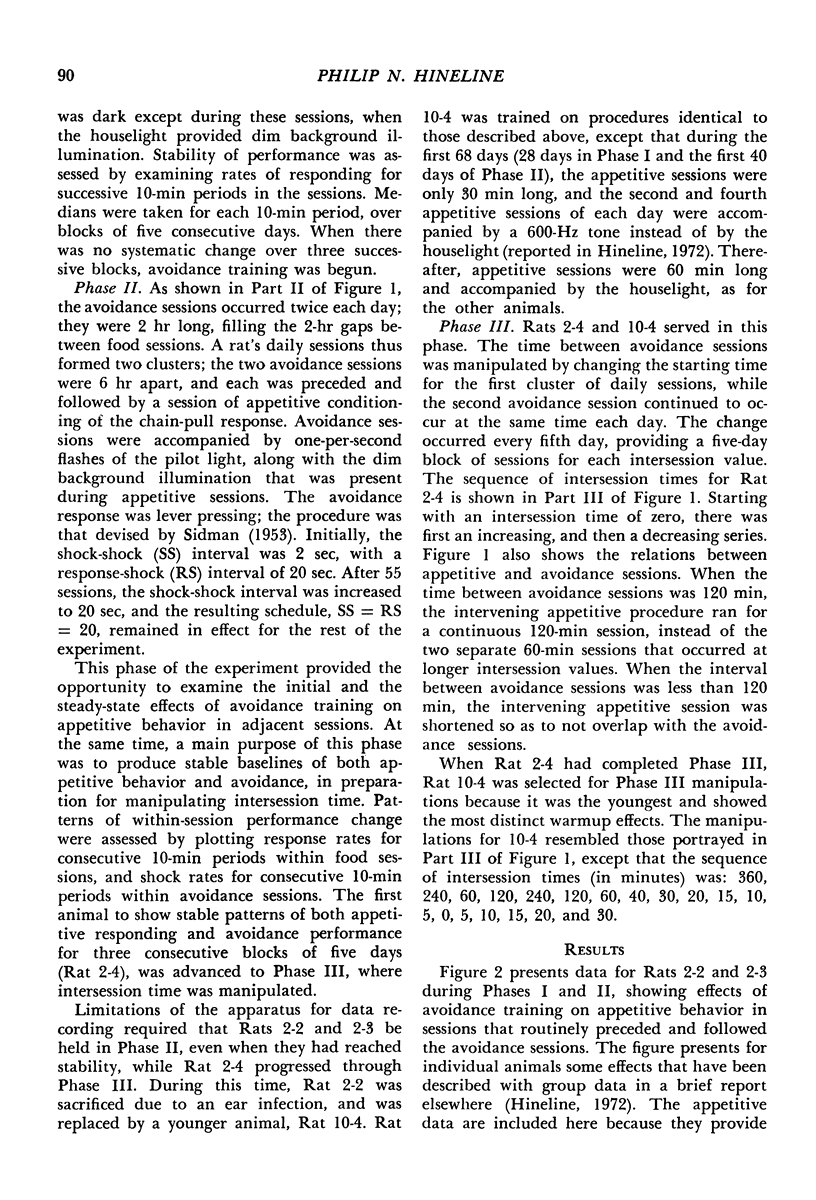
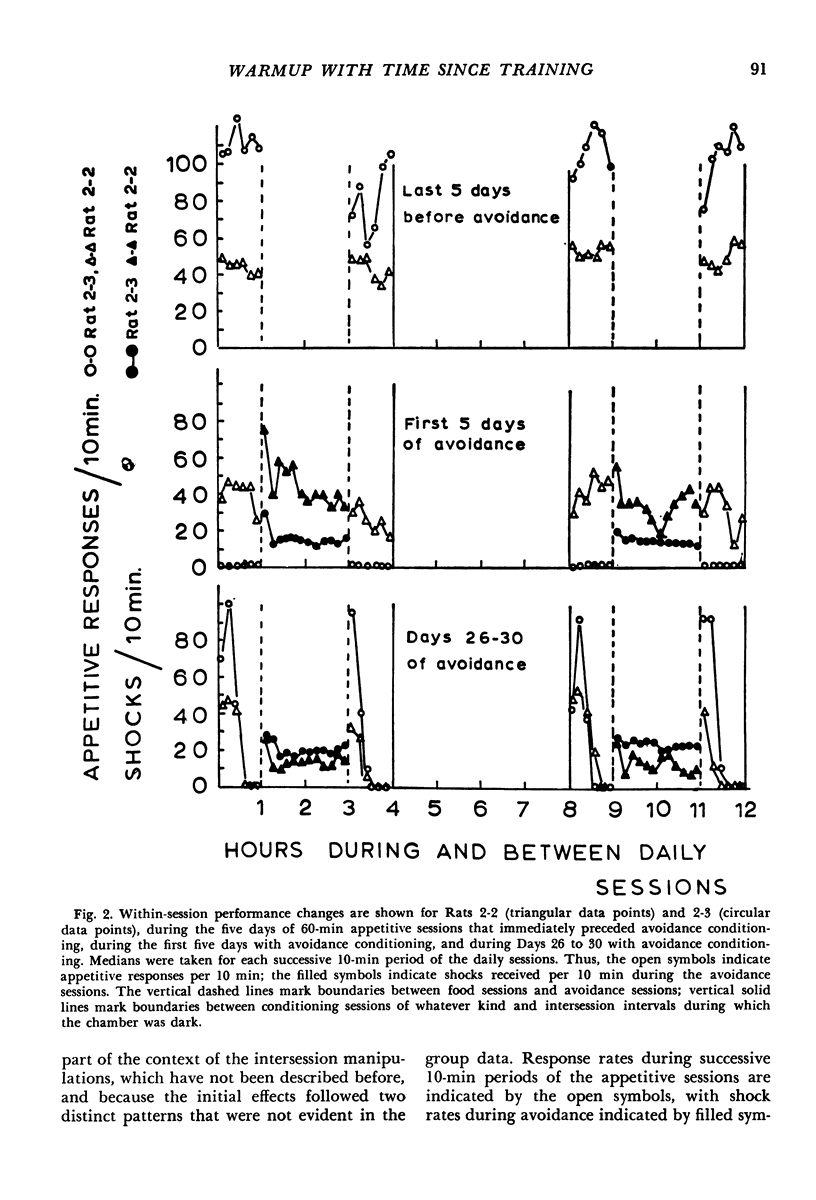

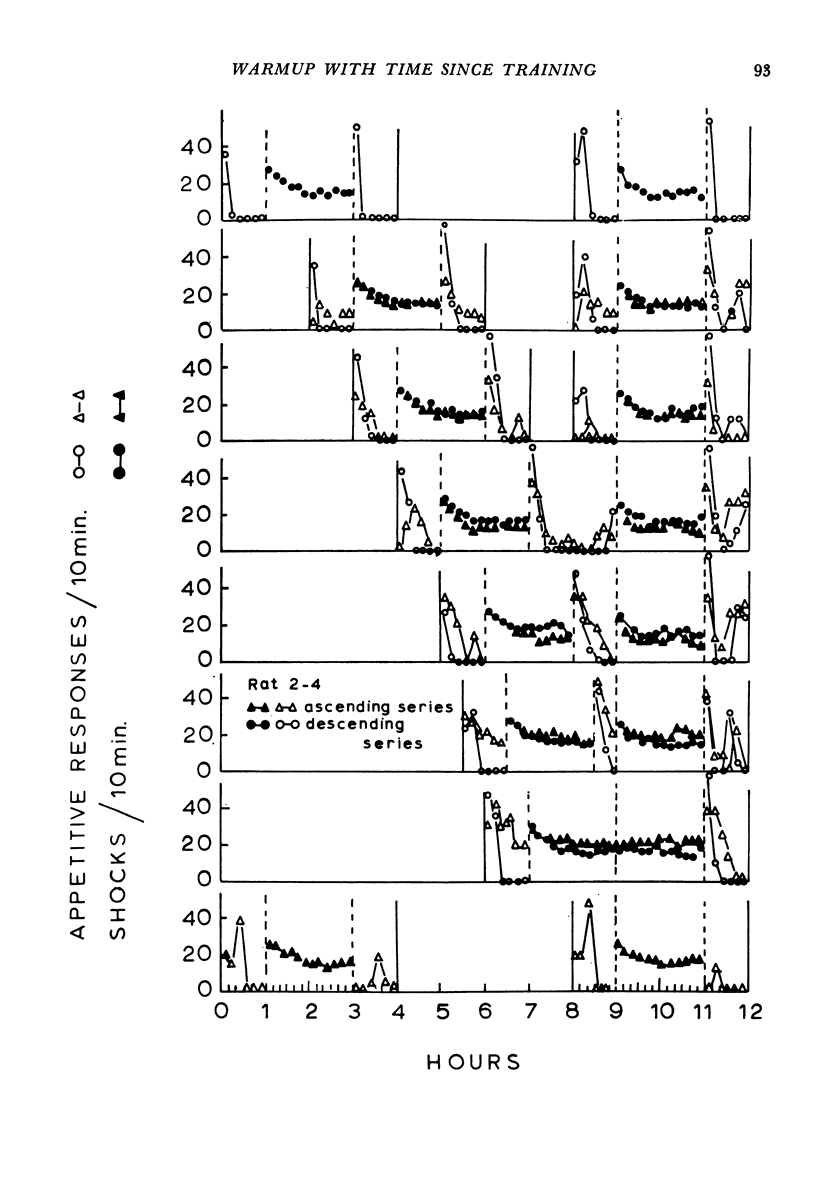
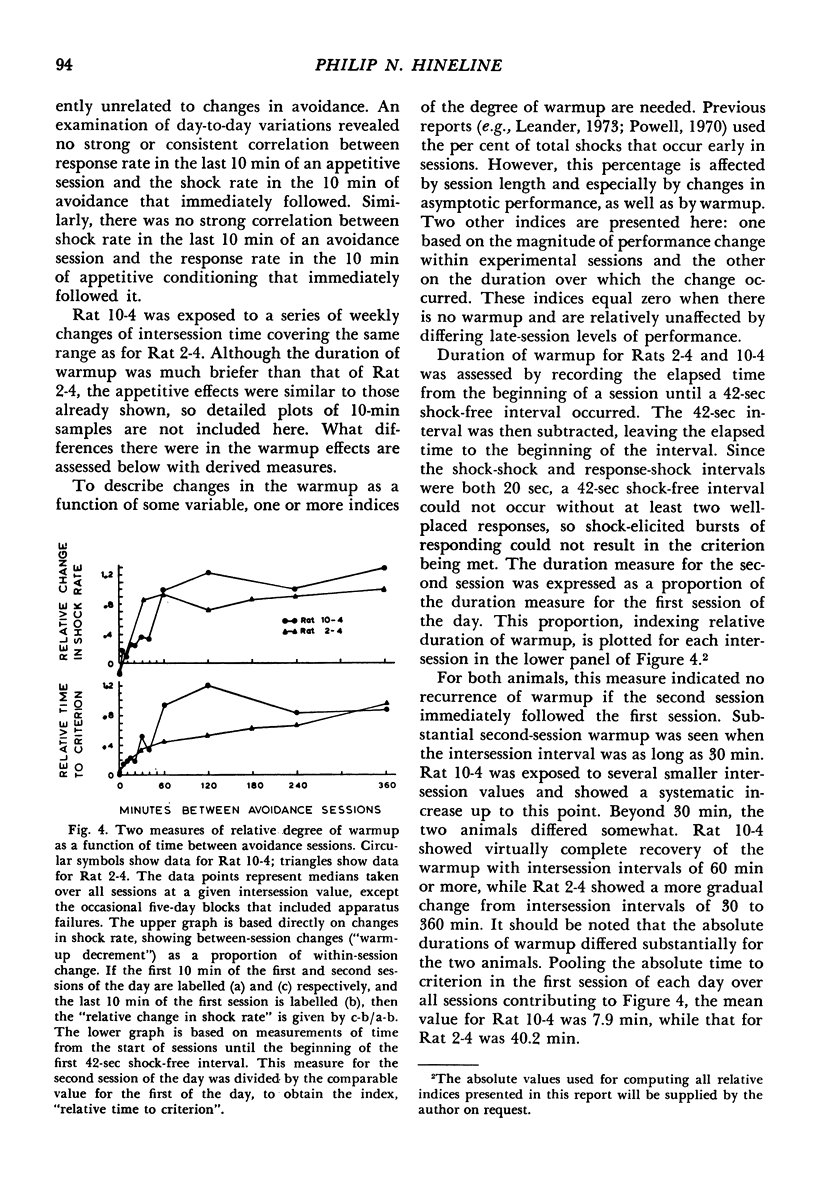
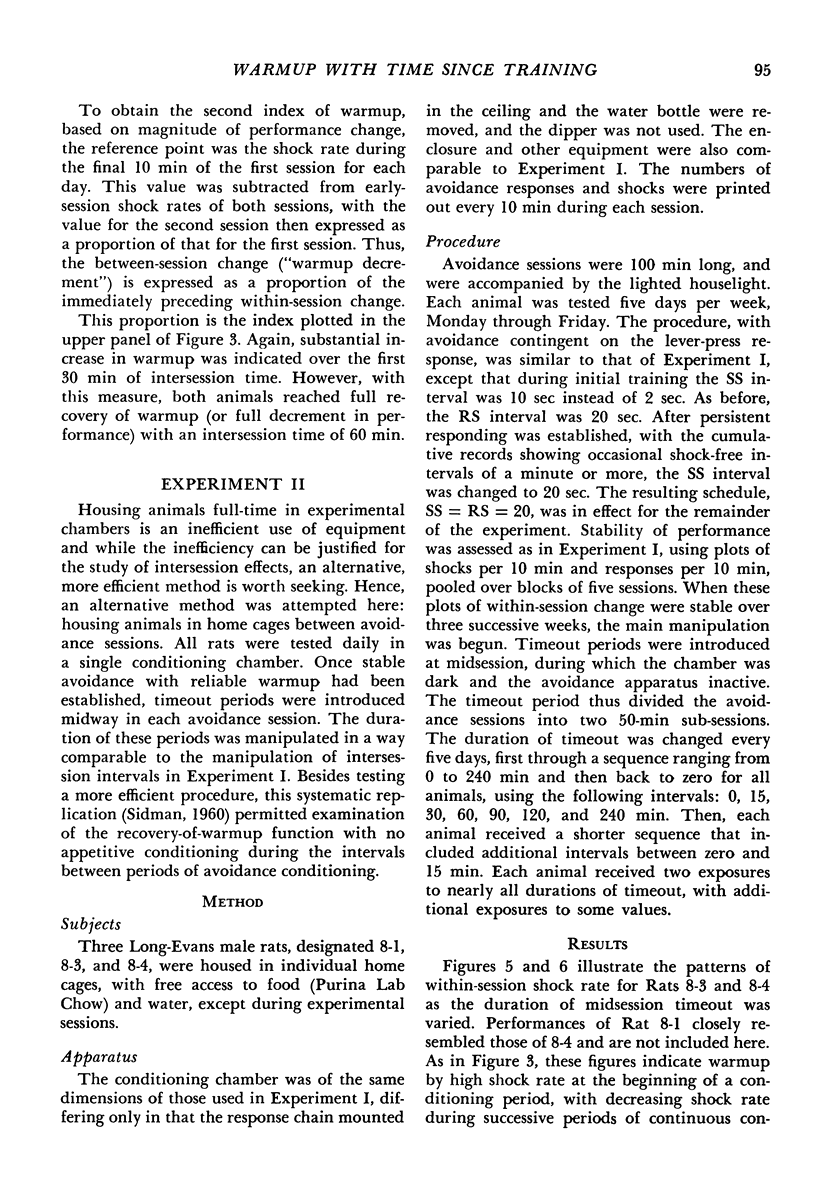
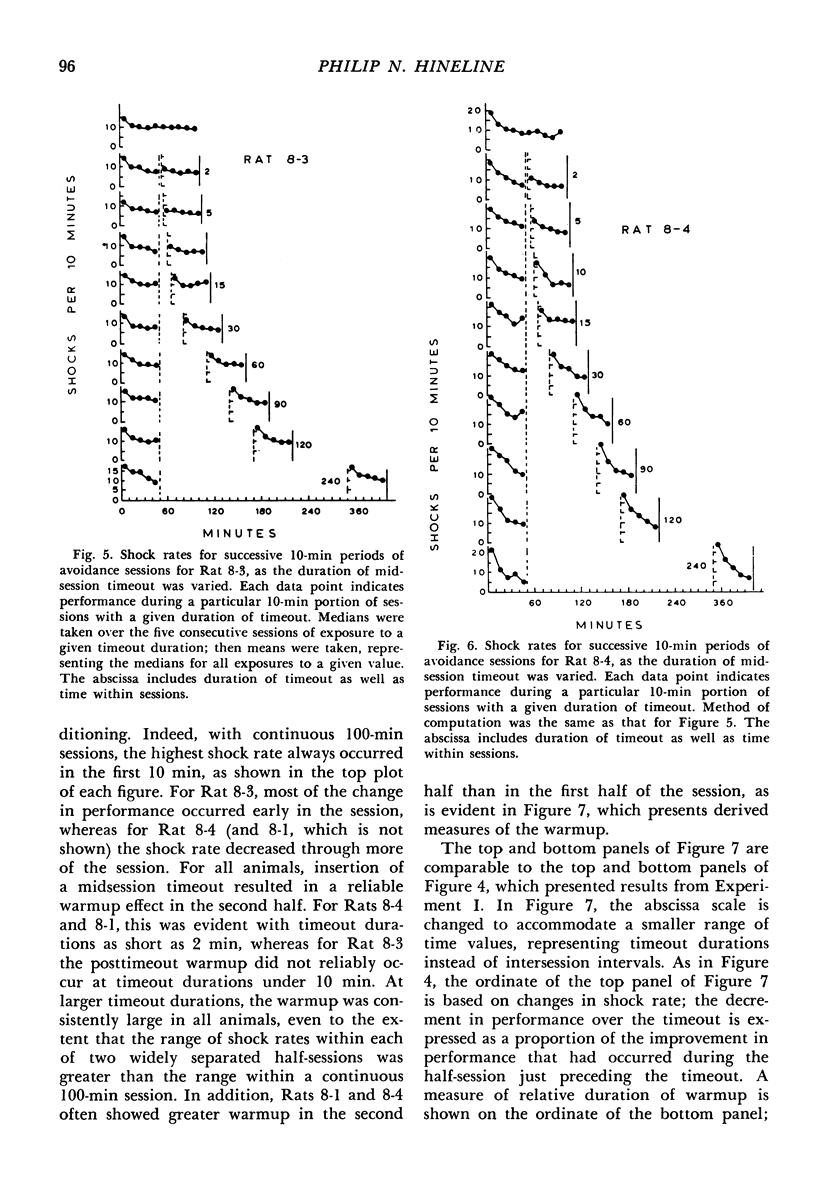
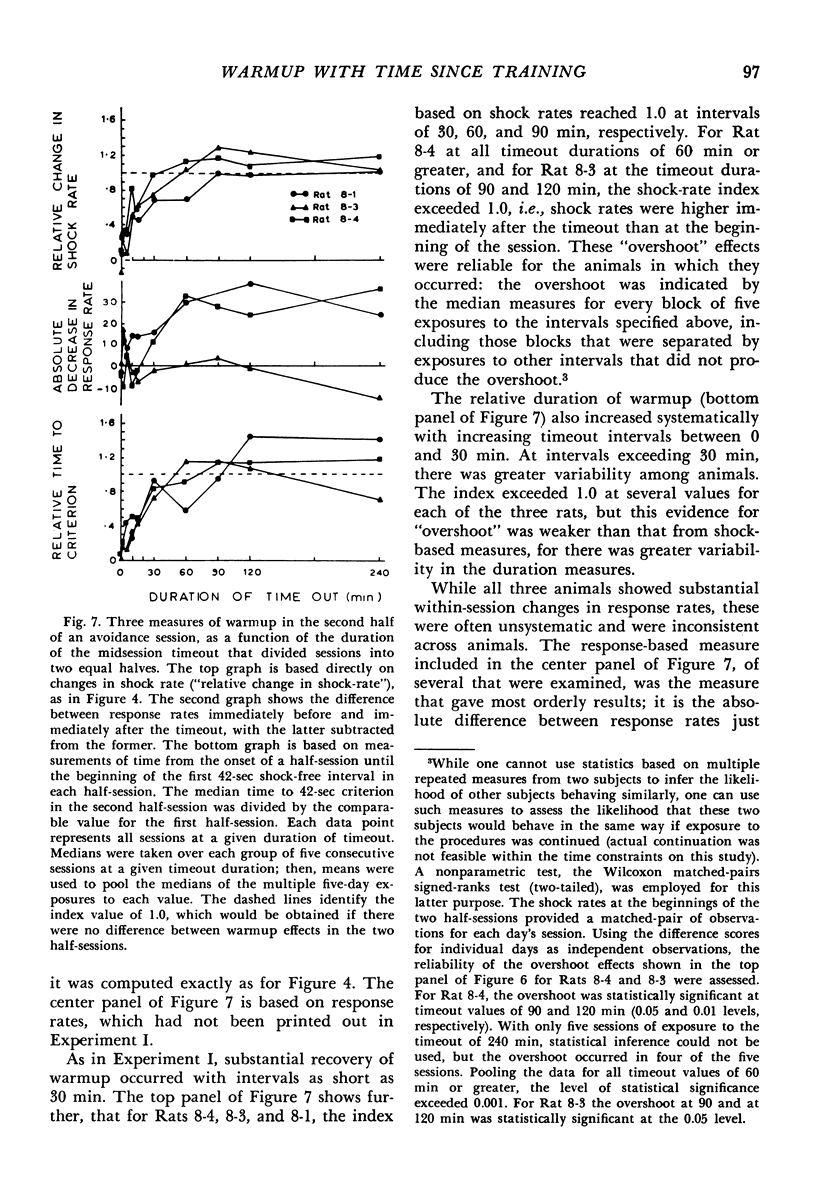

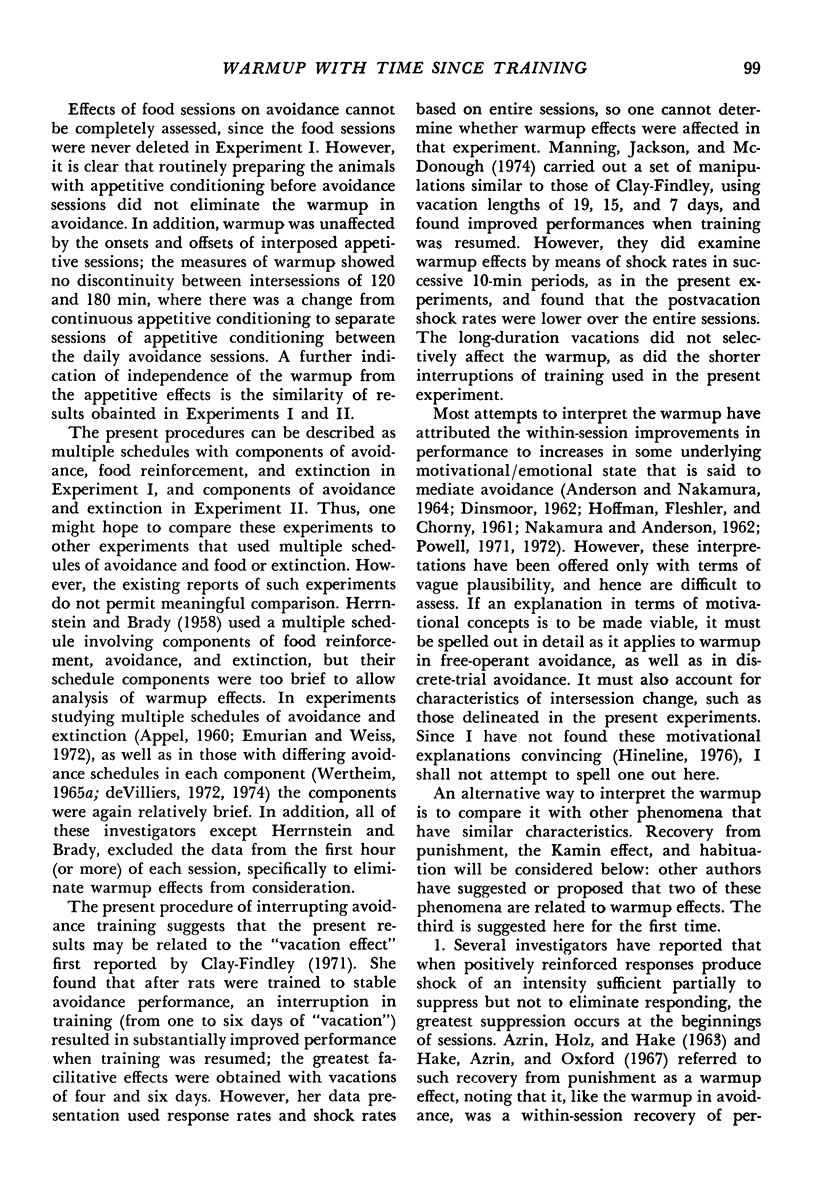
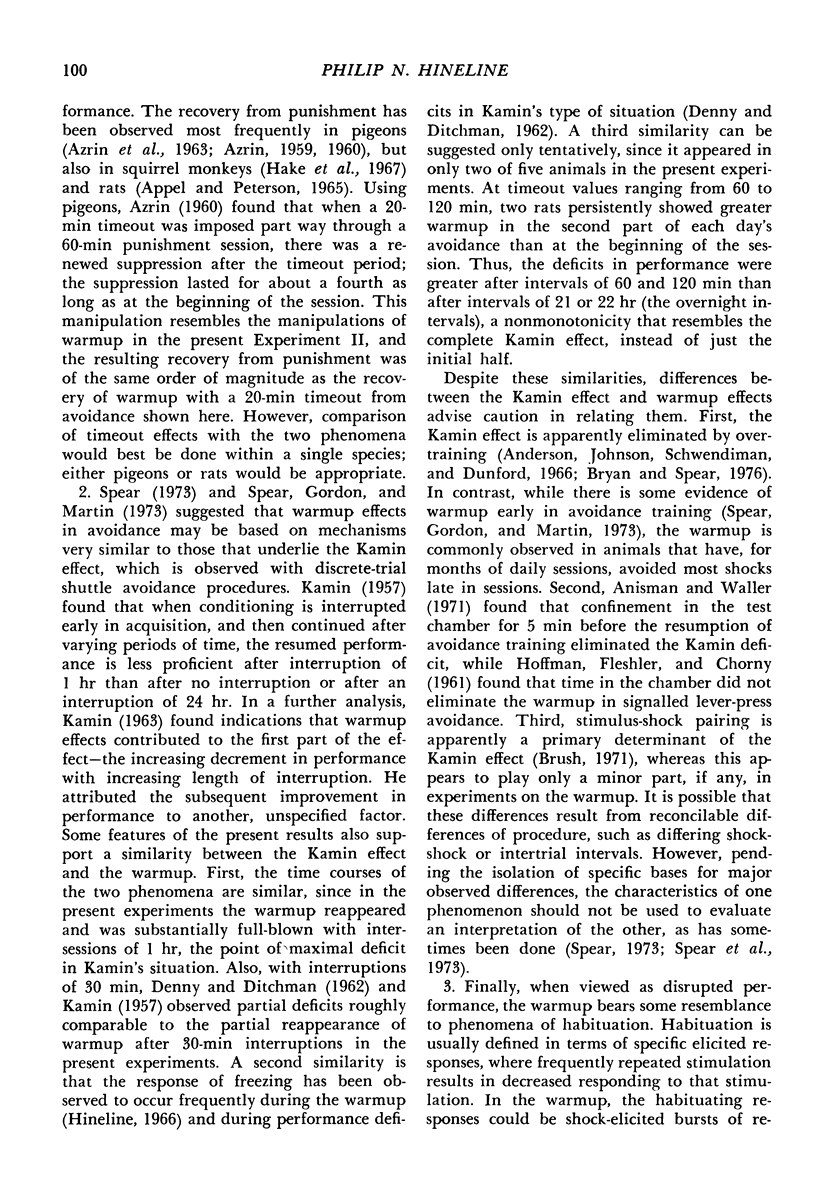
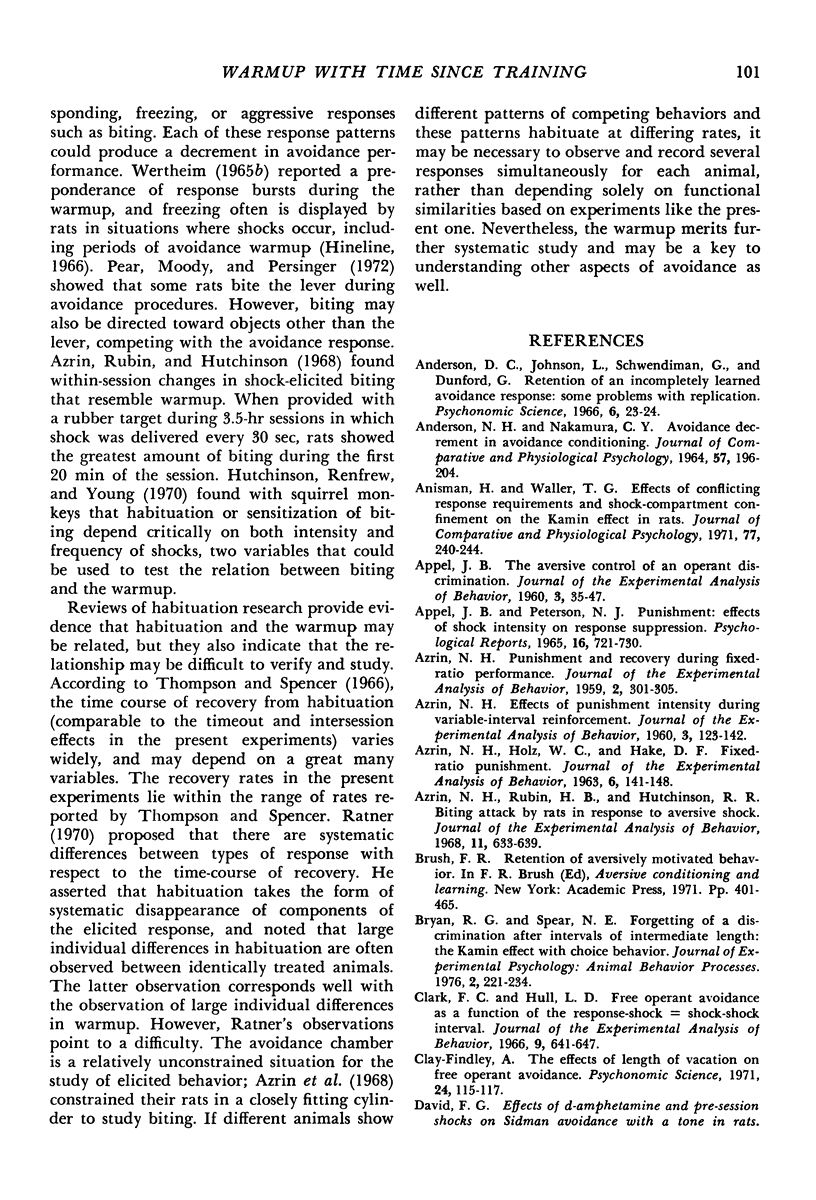
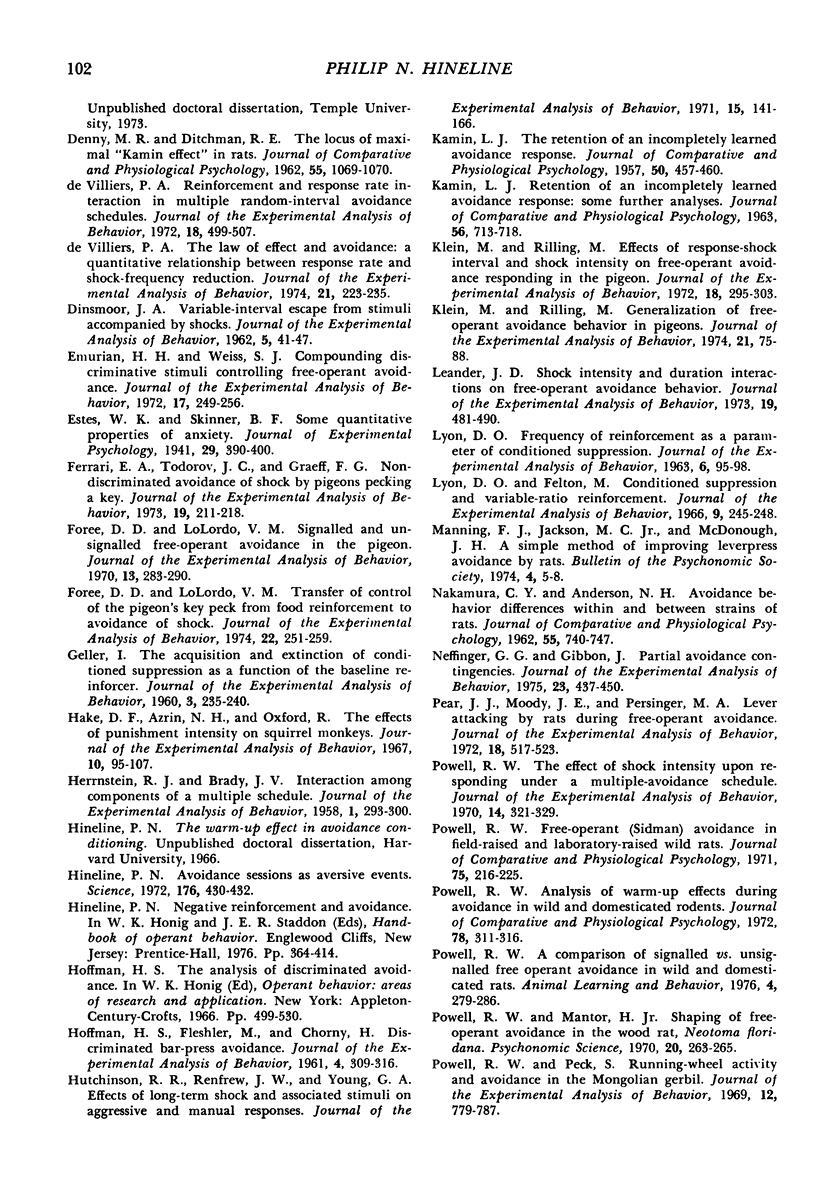
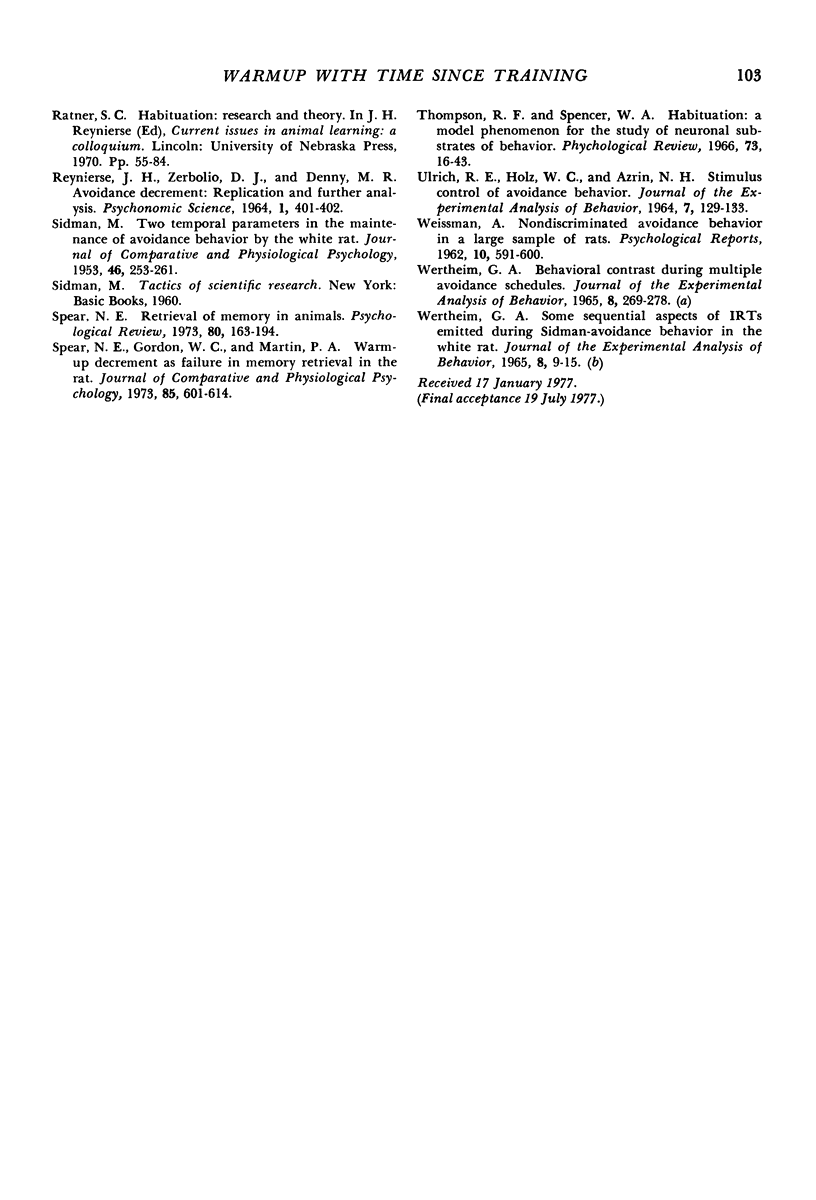
Selected References
These references are in PubMed. This may not be the complete list of references from this article.
- ANDERSON N. H., NAKAMURA C. Y. AVOIDANCE DECREMENT IN AVOIDANCE CONDITIONING. J Comp Physiol Psychol. 1964 Apr;57:196–204. doi: 10.1037/h0042221. [DOI] [PubMed] [Google Scholar]
- APPEL J. B., PETERSON N. J. PUNISHMENT: EFFECTS OF SHOCK INTENSITY ON RESPONSE SUPPRESSION. Psychol Rep. 1965 Jun;16:721–730. doi: 10.2466/pr0.1965.16.3.721. [DOI] [PubMed] [Google Scholar]
- AZRIN N. H. Effects of punishment intensity during variable-interval reinforcement. J Exp Anal Behav. 1960 Apr;3:123–142. doi: 10.1901/jeab.1960.3-123. [DOI] [PMC free article] [PubMed] [Google Scholar]
- AZRIN N. H., HOLZ W. C., HAKE D. F. Fixed-ratio punishment. J Exp Anal Behav. 1963 Apr;6:141–148. doi: 10.1901/jeab.1963.6-141. [DOI] [PMC free article] [PubMed] [Google Scholar]
- AZRIN N. H. Punishment and recovery during fixed-ratio performance. J Exp Anal Behav. 1959 Oct;2:301–305. doi: 10.1901/jeab.1959.2-301. [DOI] [PMC free article] [PubMed] [Google Scholar]
- Anisman H., Waller T. G. Effects of conflicting response requirements and shock-compartment confinement on the Kamin effect in rats. J Comp Physiol Psychol. 1971 Nov;77(2):240–244. doi: 10.1037/h0031658. [DOI] [PubMed] [Google Scholar]
- Appel J. B. The Aversive Control of an Operant Discrimination. J Exp Anal Behav. 1960 Jan;3(1):35–47. doi: 10.1901/jeab.1960.3-35. [DOI] [PMC free article] [PubMed] [Google Scholar]
- Azrin N. H., Rubin H. B., Hutchinson R. R. Biting attack by rats in response to aversive shock. J Exp Anal Behav. 1968 Sep;11(5):633–639. doi: 10.1901/jeab.1968.11-633. [DOI] [PMC free article] [PubMed] [Google Scholar]
- Clark F. C., Hull L. D. Free operant avoidance as a function of the response-shock = shock-shock interval. J Exp Anal Behav. 1966 Nov;9(6):641–647. doi: 10.1901/jeab.1966.9-641. [DOI] [PMC free article] [PubMed] [Google Scholar]
- DENNY M. R., DITCHMAN R. E. The locus of maximal "Kamin effect" in rats. J Comp Physiol Psychol. 1962 Dec;55:1069–1070. doi: 10.1037/h0048656. [DOI] [PubMed] [Google Scholar]
- DINSMOOR J. A. Variable-interval escape from stimuli accompanied by shocks. J Exp Anal Behav. 1962 Jan;5:41–47. doi: 10.1901/jeab.1962.5-41. [DOI] [PMC free article] [PubMed] [Google Scholar]
- De Villiers P. A. Reinforcement and response rate interaction in multiple random-interval avoidance schedules. J Exp Anal Behav. 1972 Nov;18(3):499–507. doi: 10.1901/jeab.1972.18-499. [DOI] [PMC free article] [PubMed] [Google Scholar]
- De Villiers P. A. The law of effect and avoidance: a quantitative relationship between response rate and shock-frequency reduction. J Exp Anal Behav. 1974 Mar;21(2):223–235. doi: 10.1901/jeab.1974.21-223. [DOI] [PMC free article] [PubMed] [Google Scholar]
- Emurian H. H., Weiss S. J. Compounding discriminative stimuli controlling free-operant avoidance. J Exp Anal Behav. 1972 Mar;17(2):249–256. doi: 10.1901/jeab.1972.17-249. [DOI] [PMC free article] [PubMed] [Google Scholar]
- Ferrari E. A., Todorov J. C., Graeff F. G. Nondiscriminated avoidance of shock by pigeons pecking a key. J Exp Anal Behav. 1973 Mar;19(2):211–218. doi: 10.1901/jeab.1973.19-211. [DOI] [PMC free article] [PubMed] [Google Scholar]
- Foree D. D., Lolordo V. M. Signalled and unsignalled free-operant avoidance in the pigeon. J Exp Anal Behav. 1970 May;13(3):283–290. doi: 10.1901/jeab.1970.13-283. [DOI] [PMC free article] [PubMed] [Google Scholar]
- Foree D. D., Lolordo V. M. Transfer of control of the pigeon's key peck from food reinforcement to avoidance of shock. J Exp Anal Behav. 1974 Sep;22(2):251–259. doi: 10.1901/jeab.1974.22-251. [DOI] [PMC free article] [PubMed] [Google Scholar]
- GELLER I. The acquisition and extinction of conditioned suppression as a function of the base-line reinforcer. J Exp Anal Behav. 1960 Jul;3:235–240. doi: 10.1901/jeab.1960.3-235. [DOI] [PMC free article] [PubMed] [Google Scholar]
- HOFFMAN H. S., FLESHLER M., CHORNY H. Discriminated bar-press avoidance. J Exp Anal Behav. 1961 Oct;4:309–316. doi: 10.1901/jeab.1961.4-309. [DOI] [PMC free article] [PubMed] [Google Scholar]
- Hake D. F., Azrin N. H., Oxford R. The effects of punishment intensity on squirrel monkeys. J Exp Anal Behav. 1967 Jan;10(1):95–107. doi: 10.1901/jeab.1967.10-95. [DOI] [PMC free article] [PubMed] [Google Scholar]
- Herrnstein R. J., Brady J. V. Interaction among components of a multiple schedule. J Exp Anal Behav. 1958 Oct;1(4):293–300. doi: 10.1901/jeab.1958.1-293. [DOI] [PMC free article] [PubMed] [Google Scholar]
- Hineline P. N. Avoidance sessions as aversive events. Science. 1972 Apr 28;176(4033):430–432. doi: 10.1126/science.176.4033.430. [DOI] [PubMed] [Google Scholar]
- Hutchinson R. R., Renfrew J. W., Young G. A. Effects of long-term shock and associated stimuli on aggressive and manual responses. J Exp Anal Behav. 1971 Mar;15(2):141–166. doi: 10.1901/jeab.1971.15-141. [DOI] [PMC free article] [PubMed] [Google Scholar]
- KAMIN L. J. The retention of an incompletely learned avoidance response. J Comp Physiol Psychol. 1957 Oct;50(5):457–460. doi: 10.1037/h0044226. [DOI] [PubMed] [Google Scholar]
- Klein M., Rilling M. Effects of response-shock interval and shock intensity on free-operant avoidance responding in the pigeon. J Exp Anal Behav. 1972 Sep;18(2):295–303. doi: 10.1901/jeab.1972.18-295. [DOI] [PMC free article] [PubMed] [Google Scholar]
- Klein M., Rilling M. Generalization of free-operant avoidance behavior in pigeons. J Exp Anal Behav. 1974 Jan;21(1):75–88. doi: 10.1901/jeab.1974.21-75. [DOI] [PMC free article] [PubMed] [Google Scholar]
- LYON D. O. Frequency of reinforcement as a parameter of conditioned suppression. J Exp Anal Behav. 1963 Jan;6:95–98. doi: 10.1901/jeab.1963.6-95. [DOI] [PMC free article] [PubMed] [Google Scholar]
- Leander J. D. Shock intensity and duration interactions on free-operant avoidance behavior. J Exp Anal Behav. 1973 May;19(3):481–490. doi: 10.1901/jeab.1973.19-481. [DOI] [PMC free article] [PubMed] [Google Scholar]
- Lyon D. O., Felton M. Conditioned suppression and variable ratio reinforcement. J Exp Anal Behav. 1966 May;9(3):245–248. doi: 10.1901/jeab.1966.9-245. [DOI] [PMC free article] [PubMed] [Google Scholar]
- NAKAMURA C. Y., ANDERSON N. H. Avoidance behavior differences within and between strains of rats. J Comp Physiol Psychol. 1962 Oct;55:740–747. doi: 10.1037/h0044433. [DOI] [PubMed] [Google Scholar]
- Neffinger G. G., Gibbon J. Partial avoidance contingencies. J Exp Anal Behav. 1975 May;23(3):437–450. doi: 10.1901/jeab.1975.23-437. [DOI] [PMC free article] [PubMed] [Google Scholar]
- Pear J. J., Moody J. E., Persinger M. A. Lever attacking by rats during free-operant avoidance. J Exp Anal Behav. 1972 Nov;18(3):517–523. doi: 10.1901/jeab.1972.18-517. [DOI] [PMC free article] [PubMed] [Google Scholar]
- Powell R. W. Analysis of warm-up effects during avoidance in wild and domesticated rodents. J Comp Physiol Psychol. 1972 Feb;78(2):311–316. doi: 10.1037/h0032191. [DOI] [PubMed] [Google Scholar]
- Powell R. W., Peck S. Running-wheel activity and avoidance in the mongolian gerbil. J Exp Anal Behav. 1969 Sep;12(5):779–787. doi: 10.1901/jeab.1969.12-779. [DOI] [PMC free article] [PubMed] [Google Scholar]
- Powell R. W. The effect of shock intensity upon responding under a multiple-avoidance schedule. J Exp Anal Behav. 1970 Nov;14(3):321–329. doi: 10.1901/jeab.1970.14-321. [DOI] [PMC free article] [PubMed] [Google Scholar]
- SIDMAN M. Two temporal parameters of the maintenance of avoidance behavior by the white rat. J Comp Physiol Psychol. 1953 Aug;46(4):253–261. doi: 10.1037/h0060730. [DOI] [PubMed] [Google Scholar]
- Thompson R. F., Spencer W. A. Habituation: a model phenomenon for the study of neuronal substrates of behavior. Psychol Rev. 1966 Jan;73(1):16–43. doi: 10.1037/h0022681. [DOI] [PubMed] [Google Scholar]
- ULRICH R. E., HOLZ W. C., AZRIN N. H. STIMULUS CONTROL OF AVOIDANCE BEHAVIOR. J Exp Anal Behav. 1964 Mar;7:129–133. doi: 10.1901/jeab.1964.7-129. [DOI] [PMC free article] [PubMed] [Google Scholar]
- WERTHEIM G. A. BEHAVIORAL CONTRAST DURING MULTIPLE AVOIDANCE SCHEDULES. J Exp Anal Behav. 1965 Sep;8:269–278. doi: 10.1901/jeab.1965.8-269. [DOI] [PMC free article] [PubMed] [Google Scholar]
- WERTHEIM G. A. SOME SEQUENTIAL ASPECTS OF IRTS EMITTED DURING SIDMAN-AVOIDANCE BEHAVIOR IN THE WHITE RAT. J Exp Anal Behav. 1965 Jan;8:9–15. doi: 10.1901/jeab.1965.8-9. [DOI] [PMC free article] [PubMed] [Google Scholar]


